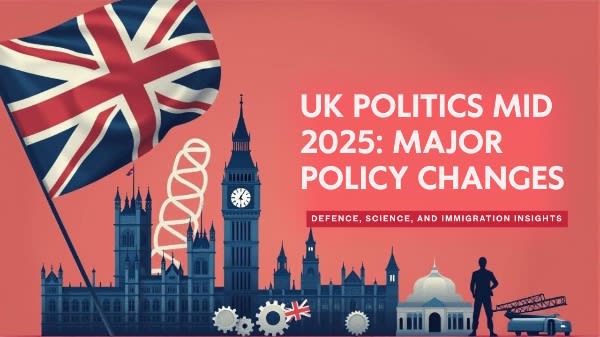Date 11 August 2025
Issue
What impact will the UK government’s mid-2025 reforms on defence, science, and immigration have on national security, innovation, and migration control?
Short Answer
The government’s agenda strengthens border enforcement, commits record sums to technological advancement, and upgrades military capacity. However, the effectiveness of these measures will depend on whether operational limits, funding pressures, and human rights concerns can be addressed.
Development
Over the previous six months, the UK government, led by Prime Minister Sir Keir Starmer, has undertaken essential immigration reforms, funded science and technology, and upgraded defences. In response to escalating national security difficulties and rising public concern about migration, these initiatives aim to restore order at the border while investing in essential industries. Critics warn that policy loopholes could degrade efficacy, cause legal problems, and aggravate social unrest.
In June 2025, the government announced plans to invest £22.5 billion each year for four years, £86 billion in science and technology R&D, focusing on artificial intelligence, sustainable energy, and pharmaceutical innovation. Regional councils will receive up to £500 million in funding to foster local innovation. According to the Spending Review 2025, R&D investment would rise to £22.6 billion annually by 2029–2030.
The Strategic Defence Review, released in June 2025, pledges to increase defence spending to 2.5% of GDP by 2027, boost troop numbers, and develop missile defence and nuclear capabilities. £2 billion will be invested in drone technologies to make the Army “ten times more lethal.”
Home Secretary Yvette Cooper has been at the forefront of immigration policy changes. A “one-in, one-out” migrant exchange arrangement with France allows the UK to expel one illegal entrant for every accepted asylum applicant (initially around 50 exchanges weekly), with the UK covering transportation costs.
Additional measures include £100 million for border security, the deployment of 300 National Crime Agency officers, a ban on smuggler-related social media adverts (with penalties of up to five years in prison), and a fast-track asylum system to resolve cases within weeks rather than years. Cooper has also proposed legal standards requiring police to identify suspects’ nationality and asylum status in high-profile cases.
Legislatively, these policies build on the Illegal Migration Act 2023 and the Safety of Rwanda Act 2024. New laws target cyber smuggling, formalise fast-track asylum changes, and adjust appeal rights and Article 8 criteria.
Analysis
Geographical Reach
R&D funding is distributed across the United Kingdom, with regional innovation awards in devolved administrations. The immigration agreement involves French ports and UK return facilities, while defence upgrades will impact domestic bases and projects such as drone infrastructure.
Strengths and Weaknesses
Sustained and increasing R&D allocations help maintain innovation momentum, but inflation could neutralise real-terms growth. Defence expenditure is designed to enhance deterrence and incorporates lessons from Ukraine, yet concerns remain over escalation risks, over-automation, and budgetary strain.
Immigration reforms show high political responsiveness. However, the limited scale of the one-in, one-out exchange, around 50 migrants per week, compared to more than 25,000 arrivals, restricts the impact. Loopholes in the appeals process may still allow removals to be delayed. Resource increases and faster asylum procedures could improve case resolution, but civil rights groups warn of fairness issues.
Have Issues Been Remedied?
Some improvements are visible: police nationality disclosure rules respond to transparency demands, smugglers’ online activities are now criminalised, and asylum backlogs are targeted through fast-track systems and additional court resources. However, legislative constraints and procedural gaps continue to slow progress.
Examples from Other Jurisdictions
Spain and Italy have trialled similar migrant exchange and fast-track asylum measures, while the US has combined deportation agreements with online smuggling crackdowns. These efforts have faced political backlash and legal challenges over human rights implications, a scenario the UK may also face.
Legislative Reach
Retaining the Safety of Rwanda Act 2024 and the Illegal Migration Act 2023 gives the government significant authority to remove individuals and limit sanctuary rights. The forthcoming legislation will expand cyber-smuggling provisions, formalise asylum reforms, and revise appeals criteria. While these measures strengthen enforcement powers, they invite scrutiny over judicial review limits and rights compliance.
Conclusion
Over the last six months, the UK has pursued a robust and far-reaching policy agenda, tightening immigration rules, strengthening national defence, and making record technological investments. While the objectives are clear, balancing deterrence with civil liberties, innovation with fiscal realities, and border control with human rights obligations remains challenging. The fast-track asylum policy, police transparency requirements, and R&D funding streams will be critical tests in determining whether these reforms can secure political stability and public trust over the coming months.
